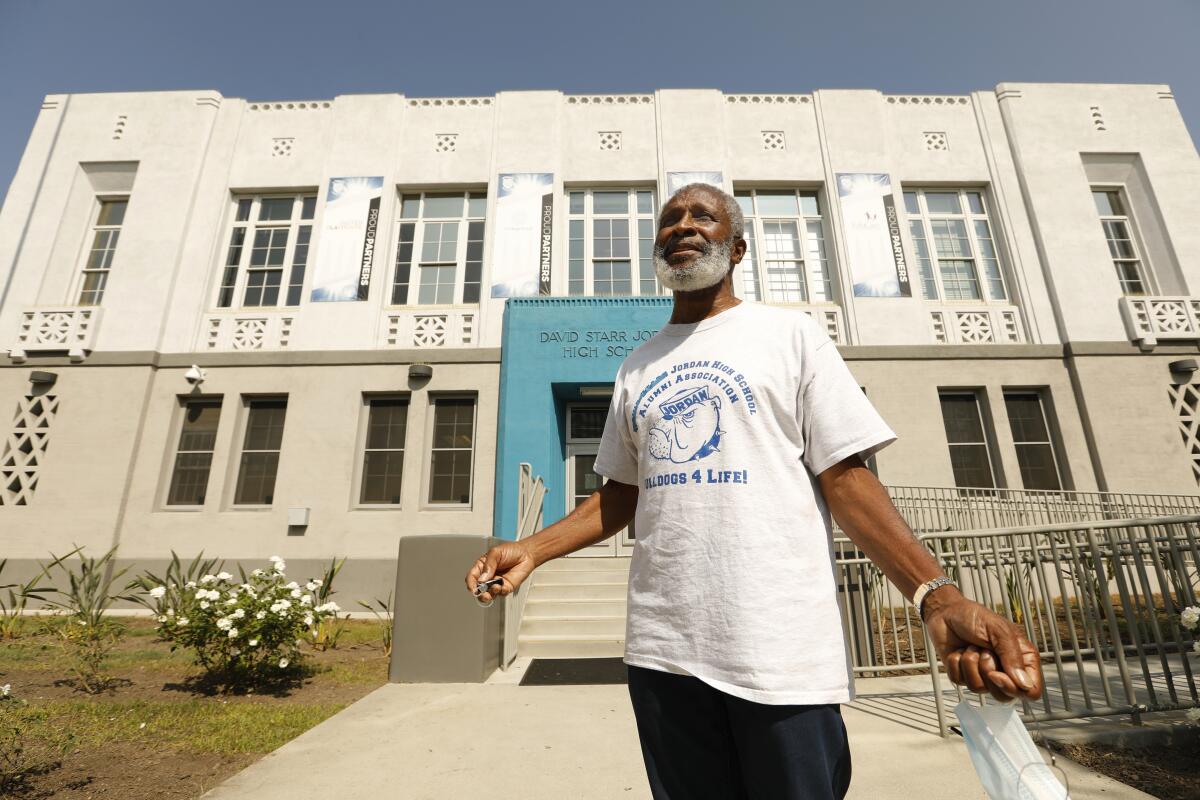Watts’ Jordan High cuts association with promoter of eugenics but keeps partial name

- Share via
David Starr Jordan High School in Watts has been renamed Jordan High, to reflect the wishes of the school community that wanted to cut ties with a promoter of the racist practice of eugenics but retain a local legacy associated with the aspirations of generations of Black and Latino students.
The renaming was ratified by a vote of the Los Angeles Board of Education on Tuesday.
“Generations of community members have proudly graced our halls,” said Principal Lucía Cerda, who grew up in the neighborhood of the Watts campus and is married to a Jordan High graduate. She told the Board of Education that the name Jordan meant something to those who wanted to support “the Jordan they know and love.”
What the school community did not want is a continued association with the person for whom the school was named. David Starr Jordan, founding president of Stanford University, figured prominently in the racist doctrine of eugenics, which in the early 20th century was couched as a scientific public health and welfare effort to control for favorable characteristics in human reproduction. In Jordan’s opinion, that meant avoiding the mixing of races that he considered to be degrading.
In June, USC stripped the name of Rufus B. von KleinSmid, the university’s fifth president, from a key building as the university reconciled with his disturbing leadership role in California’s eugenics movement. Such reconsiderations of those associated with eugenics are reverberating across colleges and K-12 school districts.
In pushing for the Jordan High name change, school and community leaders told the board that the school’s legacy is rooted in the success of its alums — famous jazz musicians, athletes and scholars — not a racist. The school opened in 1923, eight years before Jordan’s death.
“Throughout the 1930s and 1940s an exceptional group of students, legends of jazz, were developed at Jefferson and Jordan High schools beginning the genre of West Coast and Cool Jazz,” wrote Robert Collins, author of an authoritative reference of district graduates and famous dropouts.
Jordan’s legendary musicians include jazz saxophonist Gil Bernal; flutist, saxophonist, civil rights leader and educator Buddy Collette; jazz drummer and bandleader Chico Hamilton, and bassist, composer and bandleader Charles Mingus Jr. The school’s athletic champions include Olympians Hayes Sanders, Kevin Young and Florence Griffith Joyner. Another alumnus is Nobel Laureate chemist Glenn Seaborg.
The Jordan experience of alum Earl Allen spans those eras. Although his family arrived in Watts from Mississippi in the mid-1950s, he knew a woman who went to school in the 1920s with Seaborg. By the 1940s Jordan served predominately Black students, an evolution brought about by real estate covenants that prohibited Black families from purchasing homes in other parts of town. Allen recalled nearby factories that churned out solid working-class jobs as well as air pollution.
(The area retains industrial remnants — the district is currently suing an adjacent recycling plant over alleged risks to students.)
Allen remembers Black teachers who should have been college professors but were available to Jordan High because they were shut out from career opportunities. When Allen graduated in 1962, Jordan had the district’s only Black high school principal.
When Allen returns for career days, he interacts with a student body that is 82% Latino and 17% Black. He tells students to get as much education as they can for the evolving job market. The factory jobs of his parents’ day are gone. So is his own past work as a senior civilian administrator at the Long Beach Naval Shipyard.
The issue of the school’s name had been discussed among alumni for several years. Other monuments to Jordan elsewhere, including schools in Long Beach, Burbank and Palo Alto, already have been renamed or are the subject of debate.
Until recently, “nobody ever really mentioned David Starr. It was always just Jordan High School,” said 1981 grad Michael Cummings, a local pastor whose We Care Outreach Ministry is known for youth gang-prevention efforts and services to prisoners. He wanted the name to “stay Jordan High for the memories, for the good times and people who went there for the education.”
L.A. school board member George McKenna, who grew up in Louisiana, recalled taking a teaching job at Jordan High in the early 1960s, when he was barely older than his students. He described a school community that was close-knit, where school staff lived close enough to walk to school.
McKenna and Allen also recall the civil unrest that engulfed the area around the school in 1965. Soon the shifting demographic tide saw the departure of many Black middle class families and the arrival of Latino immigrants.
Mara Ponce, an academic coordinator at Jordan, graduated from the school in 2003.
“Our school prides itself on being a welcoming and inclusive environment,” she said. “At Jordan High School, we do not tolerate racism.”
In 2011, one reform effort involved replacing most of the faculty. Soon after, the district invited Green Dot Public Schools, which operates privately managed charter schools, to open on half the campus. Another nonprofit, the Partnership for Los Angeles Schools, was picked to manage the other half. The Partnership abides by existing union contracts and district rules.
Both efforts claimed progress, although challenges remain. According to the most recent available state results, about 52% of Jordan High students met or exceeded learning standards in English; 10% in math. About 98% of students are members of low-income families. Green Dot consolidation turned over the entirety of Jordan to the Partnership this year.
Another change this year is $8.5 million in upgrades since campuses closed due to the pandemic, including a new heating and air conditioning system; volleyball, tennis and futsal courts; a replacement softball field, and an upgraded irrigation system. In 2015, the L.A. Unified School District completed a $95-million campus reconstruction.
The school held a virtual town hall on July 31 to accept name submissions. A renaming committee agreed on five options. Students, staff and alumni cast 590 ballots in English and Spanish, picking from options selected by a renaming committee.
The name Jordan High School carried the day with 58%, followed by Michelle Obama High School at 13%. Another option honored the late Barbara Jordan, the first Southern African American woman elected to the U.S. House of Representatives. Other choices embellished the term “high school” as “College Preparatory High School” or “College Preparatory High School for the Arts.”
Ninth-grader Romina Calderon and her father, Luis, voted for the former first lady, but they’re OK with the results. Luis praised the helpfulness of staff when he picked up a computer for his daughter to use while schooling at home.
Romina, 14, who made straight As in middle school, wants to be a doctor.
“I want to learn more about math and science,” she said. “Jordan High will prepare me for college. It’s so important.”
More to Read
Sign up for Essential California
The most important California stories and recommendations in your inbox every morning.
You may occasionally receive promotional content from the Los Angeles Times.











